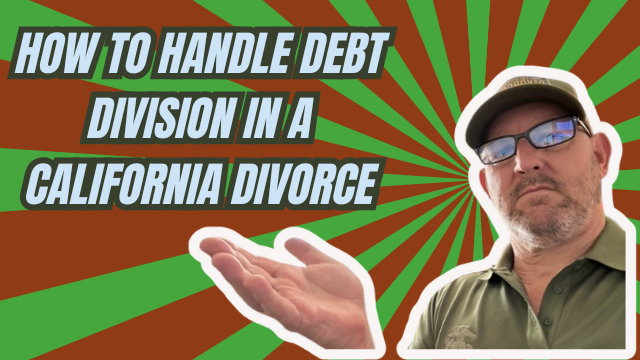How to Handle Debt Division in a California Divorce
Why dividing debt is as important as dividing assets
When you are going through a divorce in California, figuring out who gets which assets is only half the battle. Debts accumulated during the marriage are part of the property picture and can have long term financial consequences if not handled correctly. You need an agreement that is fair, clear, and approved by the court so you are not stuck paying someone elseâs obligations down the road.
Community property basics: what California law means for your debts
California is a community property state. That means most debts incurred during the marriage are considered shared community debts regardless of whose name appears on the account. Typical examples include credit card balances, personal loans, and even tax liabilities that arose while you were married.
Under community property rules, those debts are generally split 50/50 unless you and your spouse agree to a different arrangement. The key is to identify whether a debt is community or separate and then put that allocation in writing.
Common types of debt and how they are treated
- Credit cards â If charges were made during the marriage they are usually community debts even if only one spouse is on the account.
- Loans and lines of credit â Personal loans taken out for household or family expenses are typically community obligations.
- Taxes â Tax liabilities incurred during the marriage are usually treated as community debt.
- Separate debts â Debts incurred before the marriage or after legal separation may be separate, but documentation is necessary to show that distinction.
Practical options for dividing debt
You do not have to split every debt exactly 50/50. Parties can negotiate a variety of solutions that reflect what is fair and practical for both people. Common approaches include:
- Split debts 50/50 as a straightforward community division.
- Have one spouse assume more debt in exchange for a larger portion of an asset, such as savings or equity.
- Refinance or close accounts to remove one spouseâs liability where possible.
- Create a written agreement, signed by both spouses and submitted to the court, specifying who will pay what and how debts will be handled.
Real client example: trading debt for assets
Here is a concrete example of how this can work. We recently assisted a couple with over $20,000 in shared credit card debt. Rather than split the debt evenly, they negotiated an exchange: one spouse agreed to take on a larger share of the credit card balances in return for keeping a larger portion of their savings account.
We documented that agreement, prepared the necessary paperwork, and submitted it to the court. The court approved the arrangement, giving both parties certainty and a clear plan for how the debts and assets would be handled moving forward.
Why a written, court approved agreement matters
Even if you and your spouse verbally agree on how to divide debts, that agreement is not enough. Without a court order or a properly filed marital settlement agreement, creditors can still pursue either spouse for joint account liabilities. Putting the agreement in writing and getting it approved by the court protects you and reduces the risk of legal or credit problems later.
How we help: what to expect
We help you:
- Identify which debts are community and which may be separate.
- Structure a fair division that fits your financial situation.
- Draft court ready documents that clearly allocate debts and assets.
- Handle filing and paperwork so you can focus on moving forward.
Our goal is to make the process clean and correct so you do not end up responsible for obligations you did not intend to keep.
Practical tips to protect your credit during divorce
- Gather statements for all accounts and confirm when charges were made.
- Ask creditors about removing an ex spouseâs name or refinancing accounts in one name when possible.
- Do not rely on informal promises. Get the agreement in writing and approved by the court.
- Consider negotiating trades between debt and assets when that produces a fairer outcome for both parties.
Next steps
If you need help figuring out how to divide debts in a California divorce, schedule a free consultation. We will review your debts, help you identify community versus separate obligations, and prepare a court approved agreement so you can move forward with confidence.
Visit divorce661.com to schedule your free consultation and get help dividing debts cleanly and correctly.

